▼ NALSA launches web app for free legal service [06-30-17]
 NALSA has launched a web application for free Legal Services to Prisoners at the conference held at Indian Law Institute, New Delhi. NALSA has launched a web application for free Legal Services to Prisoners at the conference held at Indian Law Institute, New Delhi.
The Conference saw the participation of Member Secretaries and administrative officers of 18 State Legal Services Authorities.
The Legal Services Management System has been developed by the National Informatics Centre (NIC).
The State Legal Services Authorities and District Legal Services Authorities will feed into the web application the data for each individual prison inmate in the jails within their jurisdiction.
The feeds will have details regarding the representation of prisoners through a counsel in the court.
The software will also help in generating reports showing the total number of inmates, the number of inmates unrepresented, the number of inmates represented by legal services lawyers and the number of inmates represented by private lawyers.
All this information can be generated State wise, District wise and also with respect to each jail.
The software is also capable of generating information with regard to prisoners eligible for bail under Section 436-A Cr. P.C.
Importance of the App
- The web application will help in making the legal services system more transparent.
- It would be useful for all the concerned authorities to monitor the grant of legal aid to the prisoners to make sure that all prisoners are represented right from their first day in the court.
NALSA: Know More
- NALSA provides for free legal aid inter-alia to all persons in custody.
- It has been constituted under the Legal Services Authorities Act, 1987.
- It provides services of free legal aid in civil and criminal matters for the poor and marginalised people who cannot afford the services of a lawyer in any court or tribunal.
- Its aim is to ensure that opportunities for securing justice are not denied to any citizen by reasons of economic or other disabilities.
- NALSA also identifies specific categories of marginalised and excluded groups and formulates various schemes for implementation of legal service programmes.
- It also organises Lok Adalats for amicable settlement of disputes.
|
▼ Meet Type 055, China's most powerful destroyer [06-29-17]
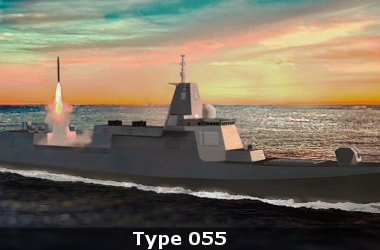 China has launched its most powerful naval destroyer, the Type 055, at the Shanghai port. China has launched its most powerful naval destroyer, the Type 055, at the Shanghai port.
The naval destroyer is one among the largest warships in the world.
The Type055 vessels will weigh more than 12,000 tonnes when fully armed.
The Type055 vessels are larger and more powerful than India’s latest Project- 15B “Visakhapatnam” class destroyers.
India is yet to commission Project- 15B “Visakhapatnam” class destroyers. India’s destroyers when fully armed will displace only 8,200 tonnes and are capable of carrying only a mix of nearly 50 surface-to-air, anti-ship and land attack missiles.
On the other hand, the Type055 vessels will combine nearly 120 missiles, making it one of the most heavily-armed ships in the world.
Chinese vessels are fitted with powerful phased array radars that are capable of focusing on targets at sea, on land and in the air.
The vessel is more modern and has more sophisticated control and battle management system. Chinese vessels are fitted with powerful phased array radars that are capable of focusing on targets at sea, on land and in the air.
The vessel is more modern and has more sophisticated control and battle management system than India’s vessels under construction.
In the last five years, China has launched several naval vessels. From March 2014, China has commissioned five Type 52D destroyers which have similar capability to that of India’s Visakhapatnam’ class warships. In addition, China has planned to build a fleet of at least 18 such naval ships.
India, on the other hand, has planned to build only seven ships belonging to the Vishakhapatnam class. Earlier this year,
China's naval technology: Know More
- China had also launched its first indigenous aircraft carrier whose construction began only in 2013. India’s indigenous aircraft carrier, the Vikrant whose construction is carried out since 2009 is unlikely to be completed before 2023.
- Growing Chinese naval prowess is a cause of worry to India.
- In the last five years, China has increasingly begun to deploy its nuclear submarines, warships and other support vessels in the Indian Ocean.
- India’s important maritime ally, the United States has also expressed its deep concerns about the expansion of the Chinese Navy, particularly in the Indian Ocean.
|
▼ India's GSAT-17 launched [06-29-17]
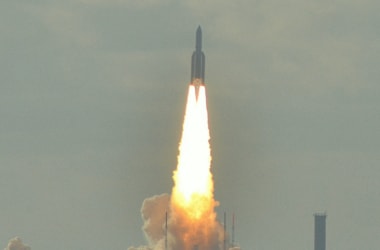 India's latest communication satellite, GSAT-17 was inducted into the INSAT/GSAT system on June 29, 2017 from Kourou, French Guiana by Ariane-5 VA-238. India's latest communication satellite, GSAT-17 was inducted into the INSAT/GSAT system on June 29, 2017 from Kourou, French Guiana by Ariane-5 VA-238.
Weighing 3477 kg at lift-off, GSAT-17 carries Payloads in Normal C-band, Extended C-band and S-band to provide various communication services. GSAT-17 also carries equipment for metereological data relay and satellite based search and rescue services being provided by earlier INSAT satellites.
GSAT-17 is designed to provide continuity of services on operational satellites in C-band, Extended C-band and S-bands.
GSAT-17 was launched into a Geosynchronous Transfer Orbit (GTO) by Ariane-5 VA-238 launch vehicle.
After its injection into GTO, ISRO's Master Control Facility (MCF) at Hassan takes control of GSAT-17 and performs the initial orbit raising manouvers using the Liquid Apogee Motor (LAM) of the satellite, placing it in circular Geostationary Orbit.
The designed in-orbit operational life of GSAT-17 is about 15 years. It was the 21st satellite that Arianespace launched for Isro since 1981
Besides GSAT-17, Ariance-5 also put into space Hellas Sat 3-Inmarsat SEAN
India added GSAT-17 to its existing fleet of 17 communication satellites with French rocket Ariane-5 successfully launching the 3,477-kg satellite from French Guiana.
The satellite has been inducted into the Indian National Satellite (INSAT)/GSAT system. It carried payloads in the normal C, extended C and S bands, providing various communication services.
GSAT-17 also had equipment for meteorological data relay and satellite-based search and rescue services being provided by earlier INSAT satellites.
Since the launch of the experimental Apple satellite in 1981, Arianespace have bagged 87% of the geostationary orbit launch contracts that India has opened to non-Indian launch systems.
Besides GSAT-17, Ariance-5 also put into space Hellas Sat 3-Inmarsat S EAN, a "condosat" for Inmarsat and Hellas Sat.
The Hellas Sat 3 payload, the second Hellas Sat satellite, will deliver DTH (direct-to-home) and telecom services maintaining and expanding Hellas Sat business reach.
Hellas Sat (member of the Arabsat Group) is a premium satellite operator, offering services in Europe, the Middle East and South Africa from the orbital position of 39 East, Arianespace said.
GSAT 17: Know More
- Launch Mass: 3477 kg
- Mission Life: 15 years
- Ariane-5 VA-238
- Type of Satellite: Communication
- Manufacturer: ISRO
- Owner: ISRO
- Application: Communication
- Orbit Type: GTO
|
▼ Fuxing: China's fastest indigenous bullet train [06-29-17]
 China launched its first self-developed ‘next-generation’ bullet train Fuxing with a maximum speed of 400 kmh on 26 June 2017. China launched its first self-developed ‘next-generation’ bullet train Fuxing with a maximum speed of 400 kmh on 26 June 2017.
The train was launched on one of the country’s busiest lines -Beijing-Shanghai line.
With the launch, Beijing aims to capture global high-speed rail market.
The first run happened simultaneously from two stations-Beijing and Shanghai. While a CR400AF model train was flagged off from Beijing South Railway Station towards Shanghai, a CR400BF model left Shanghai Hongqiao Railway Station for Beijing.
The model train on the way to Shanghai took about five hours and 45 minutes to reach its destination.
On the way, the train stopped at 10 stations, including Jinan, Shandong province and Tianjin.
The Beijing-Shanghai line sees a footfall of around 50 5000 passengers daily.
Also, China has the world’s longest railway network with 22,000 kilometres by the end of last year, about 60 percent of the world’s total.
The new bullet trains, also known as electric multiple units (EMU), boast a top speed of 400 kilometres per hour and a consistent speed of 350 kilometres an hour.
Fuxing: Know More
- The train was self-designed and manufactured by China.
- It includes a sophisticated monitoring system that constantly checks its performance and automatically slows the train in case of emergencies or abnormal conditions.
- The train is also fitted in with a remote data-transmission system, a control centre that will be able to monitor the train in real time.
- ‘Fuxing’, underpins the unique role that high-speed railway has played in China’s economic and social development.
|
▼ Scientists solve bright nights mystery [06-27-17]
 Scientists have solved the centuries-old unexplained mystery of “bright nights”, the unusual glow that appears in the sky after dark and lets observers see distant mountains, read a newspaper or check their watch. Scientists have solved the centuries-old unexplained mystery of “bright nights”, the unusual glow that appears in the sky after dark and lets observers see distant mountains, read a newspaper or check their watch.
Researchers suggest that when waves in the upper atmosphere converge over specific locations on the Earth, it amplifies naturally occurring airglow, a faint light in the night sky that often appears green due to the activities of atoms of oxygen in the high atmosphere.
Generally, it is not easy to spot the airglow but on bright nights it produces an unexplained glow that can be seen with the naked eye.
There is a lot of written record about the unusual glow in historical observations.
Historical accounts of bright nights go back centuries. European newspapers and the scientific literature carried observations of these events in 1783, 1908 and 1916.
Bright Nights do exist and they are a part of the variability of airglow that can be observed with satellite instruments.
The historical record is so coherent, it goes back over centuries and the descriptions are very similar.
Modern observations of bright nights from Earth are practically nonexistent due to pollution. Even dedicated airglow researchers have never seen a true bright night.
However, even before the advent of artificial lighting, bright nights were rare and highly localised.
Researchers could see bright night events reflected in airglow data from the Wind Imaging Interferometer (WINDII), an instrument once carried by NASA’s Upper Atmosphere Research Satellite (1991-2005).
They searched for mechanisms that would cause airglow to increase to visible levels at specific locations.
Airglow comes from emissions of different colours of light from chemical reactions in the upper reaches of the atmosphere.
The green portion of airglow occurs when light from the sun splits apart molecular oxygen into individual oxygen atoms.
When the atoms recombine, they give off the excess energy as photons in the green part of the visible light spectrum, giving the sky a greenish tinge.
To find factors that would cause an increase in airglow and create bright nights, researchers searched two years of WINDII data.
They identified 11 events where WINDII detected a spike in airglow levels that would be visible to the human eye, two of which have been described in detail in the study.
These events were four to 10 times brighter than normal airglow and could be responsible for the bright nights observed throughout history.
|
▼ ISRO satellite chips to alert people at crossings [06-27-17]
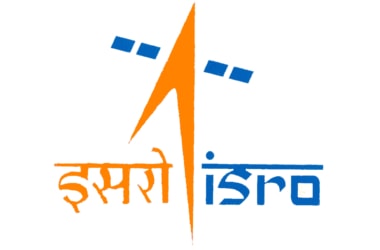 ISRO’s satellite-based chips are set to alert people at unmanned rail crossings. ISRO’s satellite-based chips are set to alert people at unmanned rail crossings.
Satellite-based chip systems developed by ISRO will be used to alert road users at unmanned level crossings about approaching trains.
These chips will also help the railways in tracking train movement on a real-time basis. Initially, on a pilot basis the ISRO-developed integrated circuit (IC) chips will be installed in the Mumbai and Guwahati Rajdhani trains.
Hooters will be installed at 20 unmanned level crossings on Rajdhani routes for Guwahati and Mumbai.
The system will warn the road users by hooters once a train approaches an unmanned level. The hooters will get activated when the train is present at a distance of about 500 metres from the level crossing, warning both road users as well as the train driver near the crossing.
The sound of the hooters will become louder as the level crossing nears, and finally it will become silent after the passage of the train.
In a phased manner, more trains would be equipped with the ISRO-developed integrated circuit (IC) chips.
The satellite based system will also be used for tracking trains about their movement on real time basis. It will be useful to passengers as at present the movement of trains are tracked manually.
Safety at Unmanned Crossings: Know More
- Safety at unmanned level crossings is a matter of concern for the Indian Railways as around 40% of accidents involving the railways happen in unmanned crossings.
- India has a total 10,000 unmanned railway crossings in the country.
- The railways has set a target for eliminating all the railway crossings in the next 2-3 years. It has eliminated 1,148 unmanned crossings in 2014-15 and 1,253 in 2015-16.
- The new technology will also help Indian railways at the time of train accidents as it can be used to get details about the exact location of trains and topography.
|
▼ Planet 10: The search for life continues [06-26-17]
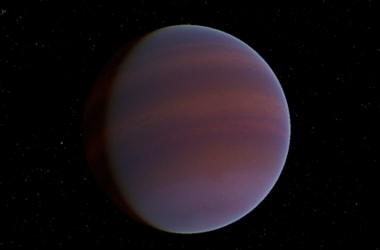 A mysterious, unseen ‘Planet 10’ may be lurking in the outer reaches of our solar system, say scientists, including one of Indian origin, who have found evidence of a Mars-like object that could be orbiting our Sun. A mysterious, unseen ‘Planet 10’ may be lurking in the outer reaches of our solar system, say scientists, including one of Indian origin, who have found evidence of a Mars-like object that could be orbiting our Sun.
This object would be different from, and much closer than, the Planet Nine - whose existence yet awaits confirmation.
Researchers, including Renu Malhotra of the University of Arizona in the U.S., found compelling evidence of a yet-to-be-discovered planetary body with a mass somewhere between that of Mars and Earth.
The mysterious mass has given away its presence only by controlling the orbital planes of a population of space rocks known as Kuiper Belt objects (KBOs) in the icy outskirts of the solar system.
While most KBOs - debris left over from the formation of the solar system - orbit the Sun with orbital tilts that average out to the invariable plane of the solar system, the most distant of the Kuiper Belt’s objects do not.
Their average plane is tilted away from the invariable plane by about eight degrees, researchers said.
This means something unknown is warping the average orbital plane of the outer solar system.
|
▼ Kalamsat: World's lightest satellite [06-23-17]
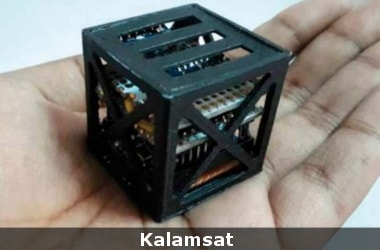 On 21st June 2017, India once again broke a global space record by launching the world's lightest satellite weighing a mere 64 grams, called Kalamsat. On 21st June 2017, India once again broke a global space record by launching the world's lightest satellite weighing a mere 64 grams, called Kalamsat.
It was designed and developed not by professional space scientists and engineers, but by 18-year-old Tamil Nadu student Rifath Sharook and his team.
The tiny satellite, named after Abdul Kalam, was flown by a Nasa sounding rocket and the lift-off was from the space agency's Wallop Island facility around 3pm (IST).
Kalam had his training in the sounding rocket programme at Wallops Island in the '60s. Kalamsat was the only Indian payload in the mission.
Mission director Srimathy Kesan announced total flight time of the rocket was 240 minutes and the satellite, assembled at her T.Nagar residence in Chennai, separated from the rocket 125 minutes after lift-off.
Kalamsat fell into the sea for safe landing.
It will be recovered and Nasa will be sending it back to India for decoding the data.
The previous Nasa mission from Wallops got postponed because of weather and India was able to launch successfully today.
This one-of-its kind satellite, which can be held in one's palm is a 3.8cm cube and its structure is fully 3-D printed with reinforced carbon fibre polymer.
It is equipped with a nano Geiger Muller counter which will measure radiation in space.
It is the only cube to be converted into a satellite in this mission.
|
▼ NASA Kepler spots 219 potential planets [06-22-17]
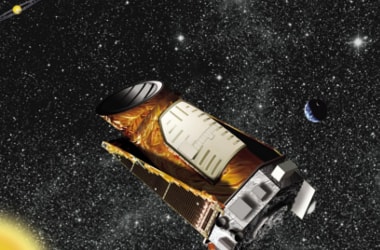 NASA’s Kepler space telescope has spotted 219 new potential planets, among which at least 10 are almost the same size as that of the Earth with conditions suitable to host life. NASA’s Kepler space telescope has spotted 219 new potential planets, among which at least 10 are almost the same size as that of the Earth with conditions suitable to host life.
The new data brings the total number of planet candidates identified by Kepler to 4034, of which 2335 have been verified as exoplanets.
So far, around 50 planets have been detected by Kepler that fall in the habitable zone and are close to the size of the Earth, among which more than 30 have been verified.
The new data is the most comprehensive and detailed catalogue release of potential exoplanets from Kepler’s first four years of data.
Exoplanets are planets that are located outside our solar system.
The data is also the final catalogue from the spacecraft’s view of the patch of sky in the Cygnus constellation.
This data will enable scientists to determine what planetary populations – from rocky bodies the size of Earth, to gas giants the size of Jupiter – make up the galaxy’s planetary demographics.
One research group used the Kepler data to make precise measurements of thousands of planets, the results of which suggest two distinct size groupings of small planets.
The team found a clean division in the sizes of rocky, Earth-size planets and gaseous planets smaller than Neptune.
Few planets falling between the groupings were also found.
The results have significant implications for the search for life.
The Kepler space telescope hunts for planets by detecting the change in a star’s brightness, as it drops when a planet is transiting from its front.
The final Kepler catalogue will serve as the foundation for further study to determine the prevalence and demographics of planets in the galaxy.
Kepler data set is unique, as it is the only one containing a population of these near Earth-analogues – planets with roughly the same size and orbit as Earth. Detecting planets in the galaxy will in turn help form the design of future NASA missions to directly image another Earth.
|
▼ China to send ecosystems to the moon [06-21-17]
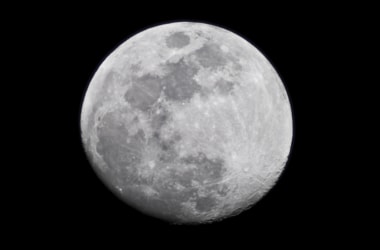 In a first, China is planning to send mini-ecosystems - containing potato seeds and silkworm eggs - to the Moon next year, in an attempt to study how the organisms develop on the lunar surface. In a first, China is planning to send mini-ecosystems - containing potato seeds and silkworm eggs - to the Moon next year, in an attempt to study how the organisms develop on the lunar surface.
The 3-kilogramme mini-ecosystem, developed by research teams led by Chongqing University in China, will be sent to the Moon by the Chang’e 4 scheduled to launch in 2018, authorities announced at the Global Space Exploration Conference.
An 18-centimetre-tall cylinder will carry potato seeds and silkworm eggs to be incubated.
The silkworms will hatch and create carbon dioxide, while the potato plants will generate oxygen, with the aim of the mission to prepare for future moon landings and possible human inhabitants.
China is planning a manned mission to the Moon, and officials have announced that the preliminary preparations for the lunar landing have begun.
|
▼ JWST targets set [06-20-17]
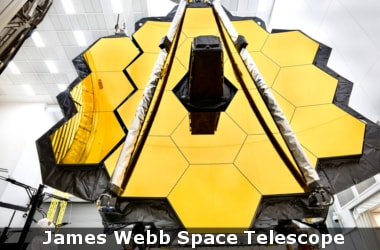 Mission officials for NASA’s James Webb Space Telescope (JWST) have announced the initial science targets for the James Webb Space Telescope. Mission officials for NASA’s James Webb Space Telescope (JWST) have announced the initial science targets for the James Webb Space Telescope.
The JWST has been scheduled to look at a large number of things in the universe including icy moons, distant exoplanets and galaxy clusters.
It will look at very first galaxies after the Big Bang, search for fingerprints of life on Enceladus, Europa, and exoplanets like TRAPPIST-1e etc.
As a part of the initial observations, 2100 observations has been planned for the JWST by the mission handlers.
JWST, being the most powerful telescope designed and built on Earth is scheduled to be launched in October 2018 on an Ariane 5 rocket from French Guiana.
James Webb Space Telescope: Know More
- JWST is a joint project of the NASA, the European Space Agency and the Canadian Space Agency. The Space Telescope Science Institute (STScI) in Baltimore will conduct Webb science operations.
- The JWST will be the successor of 26-year-old Hubble Space Telescope.
- JWST is 100 times powerful than the Hubble Space Telescope and will be the largest telescope ever sent into space.
- JWST will have a very large infrared telescope with a 6.5-meter primary mirror. Its sun shield is 22 metres which is roughly the size of a tennis court and has a mirror 6.5 metres which is over twice the size of the Hubble Space Telescope.
- The JWST is named after the former NASA administrator, James Webb. JWST was formerly known as the “Next Generation Space Telescope” (NGST).
- The National Aeronautics and Space Administration (NASA) had completed the construction of the James Webb Space Telescope (JWST) after more than 20 years of work.
- Instruments of JWST include Cameras and spectrometers that are able to record extremely faint signals. NIRSpec having programmable micro-shutters for observation of up to 100 objects. Cryocooler for cooling the mid-infrared detectors.
|
▼ China launches first X-ray telescope [06-16-17]
 China has launched its first X-ray space telescope to study black holes, pulsars and gamma-ray bursts. China has launched its first X-ray space telescope to study black holes, pulsars and gamma-ray bursts.
The telescope weighing 2.5 tonne was sent to the space using China’s Long March-4B rocket. The satellite was launched from the Jiuquan Satellite Launch Center.
Black hole refers to the remains of a supergiant star that has collapsed into itself. It is so dense and has a gravitational field so intense, that light itself cannot escape from it.
Pulsars are highly magnetized, rotating neutron stars that emit a beam of electromagnetic radiation. They are spherical, compact objects that are about the size of a large city but contain more mass than that of the sun.
Scientists are using pulsars to study extreme states of matter, search for planets beyond Earth’s solar system and measure cosmic distance.
In recent times, China sees its multi-billion-dollar space programme as a symbol of its rise.
In April, China had launched its first cargo spacecraft and successfully docked it with an orbiting space lab. This launch was hailed as a key development toward China’s goal of having its own crewed space station by 2022.
Recently, China also opened a “Lunar Palace” laboratory on earth to simulate a moon-like environment.
In the lunar palace laboratory, China is conducting experiments by housing students for up to 200 days to prepare for its long-term goal of sending humans to the moon.
In 2016, China had also successfully launched experimental X-ray pulsar navigation satellite XPNAV-1, which was world’s first pulsar navigation satellite or spacecraft.
China's First X-ray Telescope
- Hard X-ray Modulation Telescope (HXMT), named Insight, will allow scientists from China to observe magnetic fields and the interiors of pulsars and understand the evolution of black holes.
- The telescope is also expected to help scientists to search for gamma-ray bursts corresponding to gravitational waves.
- It will also study how the pulsars can be used for spacecraft navigation.
|
▼ DRDO launches Nag [06-15-17]
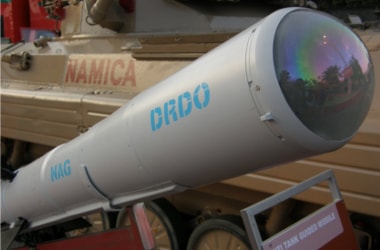 The Defence Research and Development Organisation (DRDO) has successfully test fired anti-tank ‘Nag’ missile in Rajasthan. The Defence Research and Development Organisation (DRDO) has successfully test fired anti-tank ‘Nag’ missile in Rajasthan.
The test was conducted by scientists of the Dr. A.P.J. Abdul Kalam Missile Complex at Hyderabad, Defence Laboratory at Jodhpur, High Energy Materials Research Laboratory (HEMRL) at Pune and Armament Research and Development Establishment (ARDE) at Pune.
The anti-tank Nag missile is one of the five missile systems developed by the Defence Research and Development Organization (DRDO) under the integrated guided missile development programme (IGMDP).
The four other missiles developed under this programme include Agni, Akash, Trishul and Prithvi.
The Nag missile is a third generation anti-tank guided missile which works on “fire and forget” principle.
The anti-tank Nag missile has been equipped with the highly advanced Imaging Infrared Radar (IRR) seeker along with integrated avionics.
This technology is possessed by very few nations. It also possess advanced passive homing guidance system.
The missile has been designed mainly to destroy modern main battle tanks and other heavily armoured targets.
Nag can be launched from land and air-based platforms.
The helicopter launched version known as helicopter-launched NAG (HELINA) can be fired from Dhruv advanced light helicopter (ALH) and HAL Rudra attack helicopter.
The land-based version of the missile is at present available for integration on the Nag missile carrier (NAMICA).
DRDO: Know More
- Founded: 1958
- Headquarters: New Delhi
- Motto: "Strength's Origin is in Science" (Sanskrit)
- Minister responsible: Arun Jaitley, Defence Minister of India
- Agency executive: Dr.S.Christopher, Secretary, Department of Defence R&D;
- Annual budget: 135.9 billion INR (US$2.0 billion, 2016–2017)
|
▼ First case of conjoined twin harbour porpoises discovered [06-15-17]
 Fishers off the coast of the Netherlands got quite a shock when they caught what has now been confirmed as the first case of conjoined twin harbour porpoises (Phocoena phocoena). Fishers off the coast of the Netherlands got quite a shock when they caught what has now been confirmed as the first case of conjoined twin harbour porpoises (Phocoena phocoena).
With a single body and two fully grown heads, this is a case of partial twinning, or parapagus dicephalus.
The sighting is extremely rare: these male porpoises are only the 10th known case of conjoined twins in cetaceans, a group of animals that also includes whales and dolphins.
“The anatomy of cetaceans is strikingly different from terrestrial mammals with adaptations for living in the sea as a mammal. Much is unknown.
Adding any extra case to the known nine specimens brings more knowledge on this aspect.
The fishers who made the discovery returned the twins - which were probably already dead when caught - to the ocean.
They believed it would be illegal to keep such a specimen, but were able to produce a series of photographs useful for research.
The twins died shortly after birth, because their tail had not stiffened - which is necessary for newborn dolphins to be able to swim, says Kompanje.
Other signs of their age were a flat dorsal fin that should have become vertical soon after entering the ocean water, and hairs on the upper lip, which should fall out shortly after birth.
Partial twinning can happen in one of two ways: two initially separate embryonic discs can fuse together or the zygote can only partially split during the early development process.
This case concerns the second known case of twinning, the first case of conjoined twins in Phocoena phocoena, the fourth known case of parapagus dicephalus in a cetacean species and the tenth known case of conjoined twinning in a cetacean species.
Conjoined Twins: Know More
- Not much is known about what causes conjoined twinning in cetaceans.
- In humans, conjoined twins are identical twins that are physically attached to each other.
- In healthy identical twins, an embryo splits into two after fertilization, but in conjoined twins, this process abruptly stops before the separation is complete.
|
▼ KELT 9b- Hottest giant planet discovered [06-8-17]
 Astronomers led by Ohio state university researchers discovered the hottest giant planet named KELT-9b. Astronomers led by Ohio state university researchers discovered the hottest giant planet named KELT-9b.
This exoplanet is hotter than most stars - the finding was published on June 5, 2017
KELT 9b is regarded as a hybrid planet star - it has the mass of a planet and the atmosphere of a star.
KELT 9b was discovered in 2014 as astronomers spotted the shadow as it crossed the face of its host star 650 light years away from Earth in the constellation of Cygnus.
The planet was so close to the star that surface temperature reaches more than 4300C.
This makes it the hottest giant planet ever found.
Astronomers discovered this planet using two robotic telescopes Kilodegree Extremely Little Telescope in Arizona and Sutherland to north of Cape Town in SA.
The twin telescopes focused on a star called Kelt-9 which at 10000 degrees C is nearly twice as hot as the sun. The observations revealed a regular dimming of starlight reaching Earth, the signature of a giant planet that was moving around it once every one-and-a-half days.
KELT 9b: Know More
- KELT-9b is estimated to be roughly 3777 degrees Celsius on the dark side and 4327 degrees C on the star-exposed side.
- This makes KELT-9b almost 20 per cent hotter than the next-most-boiling exoplanet WASP-33b. KELT-9b receives 700 times as much solar radiation as WASP-33b, which is similar to the glow of an entire K-type star, the second coolest type and is more than enough to break down molecules to their constituent atoms.
- The new planet’s scorching temperature is due its parent star KELT-9 which falls in the A-type bracket of stars, the third-hottest category.
- It is the seventh star of its classification to be found with an exoplanet and at roughly 300 million years old. KELT-9b is surprisingly puffy, given that its mass is almost three times Jupiter’s. KELT-9b is 2.8 times more massive than Jupiter, but only half as dense.
- For reasons no one fully understands yet, the planet also orbits its star from pole to pole, rather than around the equator as would be expected.
- The planet is tidally locked to its star as the moon is to Earth.
- One side of the planet is always facing towards the star, and one side is in perpetual darkness. Molecules such as water, carbon dioxide and methane can’t form on the dayside of the planet as it is bombarded by too much ultraviolet radiation.
- The discovery of KELT-9b might encourage more researchers to go into the depths of other planets on the opposite end of the typically researched spectrum.
|
▼ QR-SAM: India's first indigenous all weather missile [06-7-17]
 India on 4 June 2017 effectively test-fired indigenous first all weather tracked-chassis Quick Reaction Surface-to-Air Missile (QR-SAM). India on 4 June 2017 effectively test-fired indigenous first all weather tracked-chassis Quick Reaction Surface-to-Air Missile (QR-SAM).
The QR-SAM was test-fired from a mobile launcher at Integrated Test Range (ITR) at Chandipur in Odisha at around 12:39 p.m. local time.
This test of the QR-SAM was the first test of the indigenously developed sophisticated high-speed missile that is capable of destroying aerial targets, tanks, bunkers and short range missiles.
Official sources said the test was carried out for validating various parameters of the sophisticated weapon system to further strengthen its air defence system.
QR-SAM: Know More
- The QR-SAM was jointly developed by the Defence Research Development Organisation (DRDO) and Bharat Electronics Limited.
- Reports suggest that this missile system has the potential to engage multiple targets within a range of approximate 30 kilometres, with the configuration of two vehicles for area air defence.
- It is equipped for quick reaction and the system is all weather enabled, a network-centric one, which is also capable of search-on-the-move.
- It is a truck-mounted missile and is 360 degree rotatable, electronic-mechanically operated, turret-based launch unit.
- The missile, which is a highly mobile air defence system, can also deceive enemy radars making it to be detected.
- It can also be used as an anti-sea skimmer from a ship against low flying attacking missiles.
- It employs dual thrust propulsion stage using high-energy solid propellant.
|
▼ ISRO tests "FAT Boy" GSAT-19 [06-7-17]
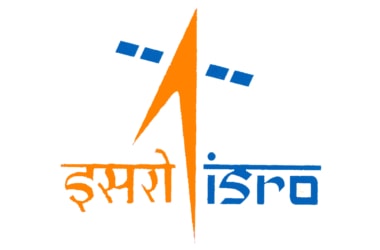 Indian Space Research Organisation (ISRO) on 5 June 2017 successfully launched the communication satellite GSAT-19 into a Geosynchronous Transfer Orbit (GTO). Indian Space Research Organisation (ISRO) on 5 June 2017 successfully launched the communication satellite GSAT-19 into a Geosynchronous Transfer Orbit (GTO).
The communication satellite was lifted by an indigenously developed launch vehicle named Geosynchronous Satellite Launch Vehicle Mark III (GSLV Mk- III) D-1 from the second launch pad of the spaceport at the Satish Dhawan Space Centre, Sriharikota at 5.28 pm.
The GSLV Mk-III is referred as FAT Boy of ISRO or India is ISRO’s its most powerful rocket.
The countdown to ISRO’s historic launch of GSLV Mark III D-1 was started on 4 June 2017 at the Satish Dhawan Space Centre, Sriharikota.
In a further advance of its space programme with this successful launch, India has managed to win a bigger share of the $300 billion global space industry.
This is the first ever developmental flight for the 4-ton class vehicle, powered by the indigenous cryogenic upper stage of 20 tonnes thrust.
In this test flight, the ISRO’s most powerful ever rocket is set to carry the satellite of 3136 kg lift off mass into space, the heaviest ever to be launched from Indian soil.
GSAT-19: Know More
- At 3136 kgs (6914 lb) the GSAT-19 satellite will be the heaviest India has attempted to put in orbit.
- The United States, Russia, China, Japan and European Space Agency have launched satellites weighing over three tonne.
Prime Minister Narendra Modi’s government has been promoting the home-grown space programme as a demonstration of low-cost technology and in February it launched 104 satellites in a single mission, most of them for foreign customers. - ISRO hopes that the launch will help it in attracting more foreign business in the heavier segment of the satellite business.
- GSAT-19 satellite with a lift-off mass of 3136 kg is the communication satellite of India, configured around the ISRO’s standard I-3K bus.
- The satellite carries Ka/Ku-band high throughput communication transponders. Besides, it carries a Geostationary Radiation Spectrometer (GRASP) payload to monitor and study the nature of charged particles and the influence of space radiation on satellites and their electronic components.
- GSAT-19 also features certain advanced spacecraft technologies including miniaturised heat pipe, fibre optic gyro, Micro-Electro-Mechanical Systems (MEMS) accelerometer, Ku-band TTC transponder, as well an indigenous Lithium-ion Battery.
- GSAT-19 was powered by indigenously-made Lithium-ion batteries.
- This was the first time when ISRO has powered a satellite for the first time with Lithium-ion batteries. Similar batteries will be used in future to power electric vehicles like cars and buses.
|
▼ Chinese discover 1000 year old temple [06-7-17]
 Chinese archaeologists have discovered the Fugan Temple, which had been lost for almost 1000 years in China’s south-western Sichuan province. Chinese archaeologists have discovered the Fugan Temple, which had been lost for almost 1000 years in China’s south-western Sichuan province.
The Temple, located in downtown Chengdu, was a famous one that lasted from the Eastern Jin Dynasty (317- 420) to the Southern Song Dynasty (1127-1279).
The archaeologists have unearthed more than 1,000 tablets inscribed with Buddhist scriptures and over 500 pieces of stone sculpture along with glazed tiles with inscriptions.
Besides this, the archaeologists have also discovered around 80 ancient tombs scattered near the temple, dating back to Shang and Zhou dynasties (1600-256 BC).
In the temple’s surroundings, they have unearthed large amounts of household tools and utensils and building materials dating back to various periods from the Song to Ming dynasties.
Chengdu became an economic and cultural centre in western China during the Sui and Tang dynasties.
A famous Tang Dynasty monk, Daoxuan, once wrote that an official rite to pray for rain to end a persistent drought was held in front of the temple and it rained as if the prayers had been heard in heaven.
The Story Behind Fugan Temple: Know More
- The story is how the Fugan Temple got its name Fugan, as it means ‘perceive the blessing’.
- The popular Tang Dynasty poet Liu Yuxi left a poem to commemorate the temple’s renovation, describing its heavenly appearance.
- The poem further noted the temple’s significant role at that time. The building was, however, worn down during the later period of the Tang and Song dynasties, with all traces of the temple disappearing during wars.
|
▼ AP launches rural lighting scheme [06-6-17]
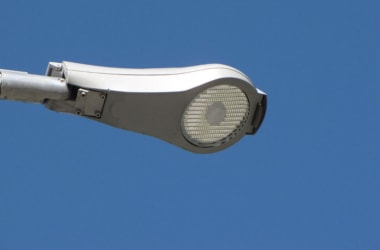 Government will retrofit 10 lakh conventional street lights with LED lights in Gram Panchayats of 7 districts in Andhra Pradesh. Government will retrofit 10 lakh conventional street lights with LED lights in Gram Panchayats of 7 districts in Andhra Pradesh.
The project will be carried out by the Energy Efficiency Services Limited (EESL) functioning under the Ministry of Power.
This project will be the first rural LED street lighting project under the Government of India’s Street Lighting National Project (SLNP).
It will help gram panchayats to cumulatively save approximately 147 million units of electricity in a year. It will lead to a reduction of approximately 12 crore tonnes of CO2.
The EESL will be made responsible for carrying out annual maintenance and warranty replacement exercises in these gram panchayats for a period of 10 years.
Andhra Pradesh became the first state to get assistance from EESL to replace conventional street lighting with LED lighting after cyclone Hudhud caused extensive damage in Visakhapatnam. Since then, EESL has installed an approximate 5,90,000 LED street lights in the State.
These lights has helped the state to reduce over 65,000 tonnes of CO2 every year. Across the country, more than 23 lakh conventional street lights have been replaced by LED street lights in 21 States.
100 Cities National Programme and SLNP: Know More
- Prime Minister Narendra Modi has launched ‘100 cities National Programme‘ on January 5, 2015 to replace conventional domestic lights with energy efficient LED lights.
- Similarly, Under the Street Light National Programme (SLNP), the government has set a target of replacing 1.34 crore conventional street lights with LED lights across the country.
- LED bulbs have a very long life, almost 50 times more than ordinary bulbs, and 8 to 10 times that of CFLs, and therefore provide both energy and cost savings in the medium term.
- The benefits of LED lights are: (i) Electricity savings (ii) Reduction of load (iii) Reduction of consumer bills (iv) Greenhouse gas emission reductions.
|
▼ Now, NASA to make artificial clouds for supporting space studies [06-5-17]
 NASA will launch the Terrier-Improved Malemute sounding rocket into the space that will release blue-green and red artificial clouds. NASA will launch the Terrier-Improved Malemute sounding rocket into the space that will release blue-green and red artificial clouds.
The launch is expected to support space studies. The launch which was originally scheduled for May 31 eventually got delayed due to poor weather conditions.
The ground stations will require clear skies to clearly view blue-green and red artificial clouds that will be produced as part of the test.
These artificial clouds will be visible from New York to North Carolina.
The rocket will eject vapour canisters between 10 to 20 km from the rocket’s main payload. These canisters will release the vapour after launch. Ground cameras will be stationed to view the vapour tracers.
The vapour tracers will be formed due to the interaction of barium, strontium and cupric-oxide. The multi-canister or ampule ejection system will facilitate the scientists to gather information over a much larger area.
The total flight time of the mission will be around 8 minutes.
What Are Sounding Rockets?
- Sounding rockets derive their name from the nautical term “to sound” that is to take measurements. The sounding rockets are short lived and follows a parabolic trajectory.
- The significance of the launch lies in the fact that the vapour traces can be helpful in studying the ionosphere.
- Since the 1950s, scientists are making use of the sounding rockets to study high-level winds and the Earth’s magnetic field.
- Since these fields are invisible to the human eye, tracer elements like barium makes their movement visible.
- It will help in the study of the motion of the charged particles in the ionosphere as well as the motion of the neutral particles in the upper atmosphere.
|
▼ NASA launches first mission for neutron stars [06-5-17]
 NASA is all set to launch the world’s first ever mission devoted for studying neutron stars. NASA is all set to launch the world’s first ever mission devoted for studying neutron stars.
NASA will launch the Neutron Stars Interior Composition Explorer, or NICER, aboard a Falcon 9 rocket.
The NICER will be installed aboard the International Space Station (ISS) as an external attached payload.
About a week after its installation, the NICER will begin observing neutron stars. The mission will focus especially on Pulsars.
During the mission, NASA will also carry out the world’s first demonstration of X-ray navigation in space. Pulsars are those neutron stars that appear to wink on and off like a cosmic lighthouse.
As these pulsars send pulsations that are predictable.
They can be used as celestial clocks for providing high-precision timing similar to that of the atomic-clock signals supplied through the Global Positioning System (GPS).
GPS signals, however, gets weakened if one travels beyond the orbit of the Earth.
On the other hand, Pulsars remain accessible virtually everywhere in space making them an apt navigational solution for deep-space exploration.
NICER will perform tests for the first time in a space technology that relies on pulsars as navigation beacons.
Pulsars and Neutron stars are nothing but the remnants of massive stars which exploded and collapsed into super-dense spheres after exhausting their nuclear fuel.
Pulsars: Know More
- Pulsars were discovered in 1967 by British astrophysicist Jocelyn Bell. It is estimated that just one teaspoonful of neutron star matter would weigh a billion tonnes on Earth.
- There have been many models that attempt to describe the physics governing the interiors of neutron stars.
- The NICER mission will help in finally testing these theories with precise observations
- Observation of neutron stars in the energetic X-ray band provides the greatest insights into their structure and the phenomenon like starquakes, thermonuclear explosions as well as of the most powerful magnetic fields known in the cosmos.
|
▼ AmbuSens – Technology to monitor ambulance patients [06-5-17]
 Indian Institute of Technology, Kharagpur has developed a wireless technology called AmbuSens for remote monitoring of condition of those patients who are ferried in ambulances. Indian Institute of Technology, Kharagpur has developed a wireless technology called AmbuSens for remote monitoring of condition of those patients who are ferried in ambulances.
AmbuSens will help in wireless monitoring of various physiological conditions of patients who are ferried in ambulances.
The AmbuSens system includes both hardware and software. The ambulance and the hospitals will have laptops or tablets with internet connection to continuously monitor the health condition of the patients in real-time.
The patients will be fitted with wireless body sensors.
The technology will monitor the parameters like ECG, heart-rate, temperature and blood-pressure and can ensure remote monitoring of the patient’s condition even before they reach the hospital.
The web interface of the system will offer easy-to-use graphical interface with data visualisation tools such as real-time ECG graph rendering.
The graphical interface can be accessed from internet-enabled laptops, tablets and smartphones. The collected patient’s data will be held confidentially.
This new system assumes significance at the backdrop of limited knowledge of medical technician who accompanies a critical patient in an ambulance.
With this technology, the doctors will be able to instruct life saving medical interventions to the technician.
|
▼ LIGO detects G-waves from black hole merger the 3rd time [06-5-17]
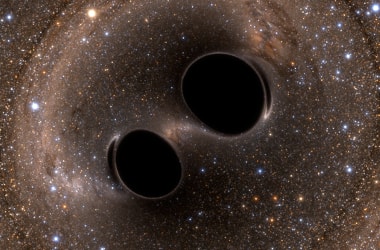 LIGO detects G-waves from black hole merger the 3rd time LIGO detects G-waves from black hole merger the 3rd time
The Laser Interferometer Gravitational-Wave Observatory (LIGO) in January 2017 detected another merger of two black holes forming gravitational waves.
The findings were published in the Physical Review Letters on 1 June 2017.
Named as GW170104, this is the third confirmed detection of gravitational waves coming from a binary black hole merger.
This time, the detection has revealed not merely a black hole merger, but also the alignment of the spins of the black holes. This can help the scientists in finding out the way the black holes were formed.
This supports the theory which says that black holes form independently in a star cluster, then sink to the centre of the cluster and eventually merge.
Until the first detection of gravitational waves by LIGO in 2015 (GW150914), it was not known that such massive black holes could exist.
The study had a major Indian contribution and the LIGO-India facility which will join the club in 2024. US-based LIGO has discovered a new population of black holes with masses that are larger than what had been seen before with X-ray studies.
The three confirmed detections by LIGO (GW150914, GW151226, GW170104) and one lower-confidence detection (LVT151012) point to a population of stellar-mass binary black holes that are larger than 20 solar masses.
The gravitational wave detection was for the first time, a chance event; second time a coincidence and third time a pattern.
The observation also yields support to Einstein’s General Theory of Relativity. According to this theory, gravitational waves, unlike light waves, will not disperse as they travel through space.
This too has been confirmed by the analysis of the presently detected signal.
Einstein's Theory: Know More
- The general theory of relativity describes the force of gravity.
- Einstein wasn't the first to come up with such a theory — back in 1686 Isaac Newton formulated his famous inverse square law of gravitation.
- In 1905, Albert Einstein determined that the laws of physics are the same for all non-accelerating observers, and that the speed of light in a vacuum was independent of the motion of all observers.
- This was the theory of special relativity.
- It introduced a new framework for all of physics and proposed new concepts of space and time.
|
▼ Now, Australian scientists discover faceless fish! [06-2-17]
 A team of Australian scientists in May 2017 discovered a faceless fish and other weird and wonderful creatures in the deep waters of Australia during their scientific journey to the parts of the ocean never explored before. A team of Australian scientists in May 2017 discovered a faceless fish and other weird and wonderful creatures in the deep waters of Australia during their scientific journey to the parts of the ocean never explored before.
The search area was the most unexplored environment on earth. The scientists have been surveying the dark and cold abyss that was four kilometres (2.5 miles) below the surface through nets, sonar and deep-sea cameras.
They came across an unusual faceless fish, which has only been recorded once before by the pioneering scientific crew of HMS Challenger off Papua New Guinea in 1873.
It hasn’t got any eyes or a visible nose and its mouth is underneath.
Bright red spiky rock crabs, puffed-up coffin fish, blind sea spiders and deep sea eels were collected by the team during their voyage from Launceston in Tasmania north towards the Coral Sea.
Another discovery was of carnivorous sponges that have lethal spicules made of silicon, effectively glass.
They get small crustaceans hooked on their Velcro-like spines to be slowly digested in-situ. This technique differs from most deep-sea sponges which feed on bacteria.
Life at such depths is one of crushing pressures, as there is no light, little food and freezing temperatures with animals evolving in unique ways to survive.
As food is scarce in such depths, these animals spend their lives floating about and lie in wait until food comes to them.
At such huge depths, it is so dark that creatures often have no eyes or produce their own light through bioluminescence.
|
▼ NASA probe to stars named after Eugene Parker [06-2-17]
 The National Aeronautics and Space Administration (NASA) on 31 May 2017 renamed the Solar Probe Plus Spacecraft, NASA’s first mission to a star which will be launched in 2018, as the Parker Solar Probe in honour of astrophysicist Eugene Parker. The National Aeronautics and Space Administration (NASA) on 31 May 2017 renamed the Solar Probe Plus Spacecraft, NASA’s first mission to a star which will be launched in 2018, as the Parker Solar Probe in honour of astrophysicist Eugene Parker.
The announcement was made at a ceremony at the University of Chicago, where Eugene Parker serves as the S Chandrasekhar Distinguished Service Professor Emeritus at the Department of Astronomy and Astrophysics.
Eugene Parker was the first to predict the existence of the solar wind back in 1958. He theorized that the sun constantly sends out a flow of particles and energy called the solar wind.
This is the first time NASA has named a spacecraft for a living individual.
The article was based on the observations of Parker which showed that there was high speed matter and magnetism constantly escaping the sun which affected the planets and space throughout our solar system.
He proposed a number of concepts about how stars including sun give off energy. This phenomenon has been proven to exist repeatedly through direct observation and it was named as the Solar Wind.
Parker’s observation forms the basis for understanding about how stars interact with the worlds that orbit them.
Parker also theorized an explanation for the superheated solar atmosphere, the Corona, which is contrary to what was expected by physics laws.
As per his theory, Corona is hotter than the surface of the sun itself.
Many NASA missions since then have continued to focus on this complex space environment known as Heliophysics.
Parker Solar Probe will be launched during a 20-day window that opens on 31 July 2018.
|
▼ NASA technology makes drone landing safer [06-2-17]
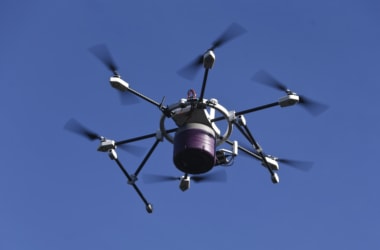 NASA scientists are developing a technology to help drones land safely during emergencies. The announcement regarding the new technology was made by NASA on 25 May 2017. After eight test flights, the technology has successfully spotted safer landing zones like swamps or drainage ditches to crash instead of on top of people’s cars. NASA scientists are developing a technology to help drones land safely during emergencies. The announcement regarding the new technology was made by NASA on 25 May 2017. After eight test flights, the technology has successfully spotted safer landing zones like swamps or drainage ditches to crash instead of on top of people’s cars.
This crash-landing software for drones was developed by Patricia Glaab, an aerospace technologist at NASA Langley Research Centre, and her fellow NASA colleague Lou Glaab.
The software links on-board drone components like batteries and motors to monitor their health.
The technology help them identify when something on the drone goes wrong, and puts the aerial vehicles in a crash-landing mode.
When triggered, the software checks a pre-installed database of nearby safe zones and identifies one for safe landing. The software also incorporates technology that lets drones recognise and avoid objects on the ground using on-board cameras.
|
▼ Scientists slow down cancer cell growth [06-2-17]
 Researchers in the United States have reportedly identified a new way to slow down the growth of cancer cell, according to reports released on 28 May 2017. Researchers in the United States have reportedly identified a new way to slow down the growth of cancer cell, according to reports released on 28 May 2017.
The research, conducted by researchers belonging to the University of Rochester in the US, has been published in the latest issue of the journal, Science.
The new method involves a protein called Tudor-SN and the gene-editing technology CRISPR-Cas9.
Researchers after a comprehensive study discovered how Tudor-SN is significant in the preparatory phase of the cell cycle, the period when the cell gets ready to divide.
Tudor-SN is more abundant in cancer cells than in the healthy ones and so, targeting the protein could help slow down the fast-growing cancer cells.
The findings were made in kidney and cervical cancer cells in the laboratory and though they are still a long way from being applied on people, they could help cancer patients in the future.
|
▼ New glass frog species in Ecuador [06-2-17]
 A group of scientists have discovered a new species of glass frog, of the genus Hyalinobatrachium. A group of scientists have discovered a new species of glass frog, of the genus Hyalinobatrachium.
The frog’s beating heart can be seen right through its chest. The new species, Hyalinobatrachium yaku was found in the Amazonian lowlands of Ecuador.
The frog boasts green spots across its back and a ‘red heart fully visible’ underneath, visible due to the transparent membrane around its organs.
Though Hyalinobatrachium yaku is not the only see-through species in existence, its markings, unusual call, and reproductive behaviour set it apart from the rest.
Given their habitat in the Amazonian lowlands, the researchers warn that these frogs are at risk. Apart from environmental concerns such as water pollution, extraction of natural resources, increased the level of regional road development, could also threaten populations of the new species.
Oil extraction and the resulting road development could destroy their habitat and create barriers between nearby populations, preventing their dispersal and interaction.
The glass frogs belong to the amphibian family Centrolenidae.
Glass Frog: Know More
- While the general background coloration of most glass frogs is primarily lime green, the abdominal skin of some members of this family is transparent.
- The internal viscera, including the heart, liver, and gastrointestinal tract, are visible through the skin, hence the common name is given glass frog.
- They are arboreal animals, meaning they spend most of their lives in trees and will come to the ground only during the mating season.
- Females lay 20 to 30 eggs on the underside of leaves that hang right above the water.
- Males guard the eggs until these are ready to hatch and fall on the below water stream. As of now, more than 60 different species of glass frogs are known, the latest being Hyalinobatrachium yaku.
|